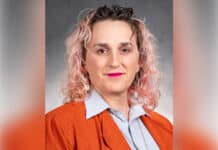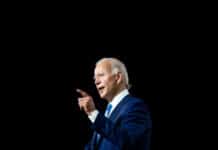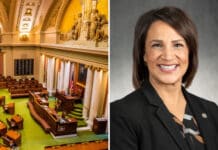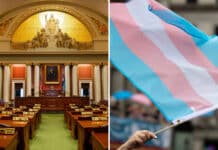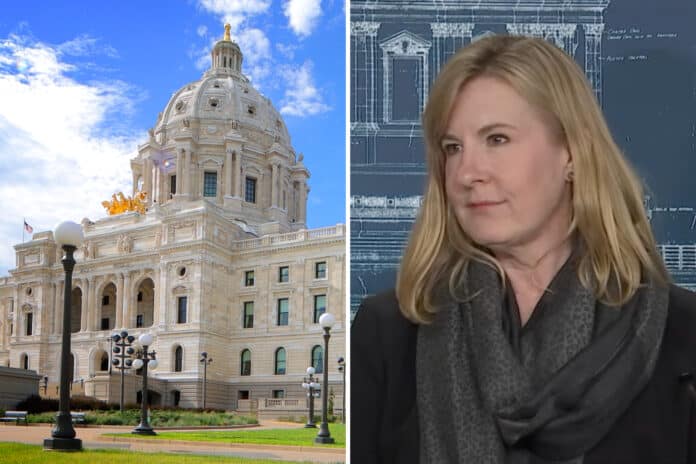
Before Melissa Hortman announced last week that her DFL colleagues in the Minnesota House of Representatives had reelected her to lead their caucus for the next two years, the top-ranking Democrat in the lower chamber faced the press to explain why her party fell short of its election goals.
The House DFL was unable to defend its continually shrinking representation in Greater Minnesota and failed to flip any seats, including in the suburbs.
Hortman, of Brooklyn Park, was easily reelected to her 11th term in the state House on Nov. 5. But despite the DFL losing its majority status in the House last week, Democrats rewarded Hortman by electing her their caucus leader for another biennium, a role she’s held since 2017.
When asked why Democrats failed to flip any suburban districts they targeted and how they lost three DFL-controlled seats in St. Peter, Winona and on the Iron Range, Hortman was transparent—she blamed a Trump-fueled Republican wave across rural America.
“So we’ve seen a geographic realignment across the world and across the country and in Minnesota where our rural areas are becoming increasingly red, and our urban and suburban areas are becoming increasingly blue,” Hortman told media members during a post-election press conference she led at the Capitol last week. “And we see this trend has really accelerated in the years Trump has been on the ballot.”
In 2016, the Republicans, who already controlled the Minnesota House of Representatives, expanded their majority by three seats. They lost that majority in 2018, considered a “Blue Wave” year for Democrats. And while the GOP couldn’t flip control of the House in 2020, they did cut into the DFL’s majority by flipping five seats from blue to red.
Last week was no different as the DFL continued to lose ground in Greater Minnesota, which Hortman described as its “toughest battle.”
“It’s the geographic realignment of where people choose to live and how the partisan divide is reflected in those communities,” Hortman said as her number two, Rep. Jamie Long, observed that the House DFL earned more votes statewide than House Republicans.
The DFL and its allies also spent some of their campaign war chest on attempting to flip two east metro seats, 41A and 41B. In both of those races, Democrat candidates outspent their opponents by an almost 2-to-1 margin, and still lost both of those seats.
“When you try to flip a seat from Republican to Democrat in a year that is trending Republican, I think that is a tall order,” Hortman said.
The biggest surprise to many was when former Washington County Commissioner Wayne Johnson defeated retired police officer and Afton City Council member Lucia Wroblewski in an open contest for 41A, just two years after Republican Mark Wiens won the seat by 102 votes. That district spans Lake Elmo, Afton, parts of Cottage Grove and a number of smaller St. Croix River Valley communities.
To the south, in a 41B district that represents most of Cottage Grove and Hastings, Republican Tom Dippel defeated DFLer Jen Fox by two percentage points. He will head north to St. Paul in January to replace outgoing GOP legislator Shane Hudella, who chose not to seek reelection.
Given those victories for the Republicans, the 67 incoming GOP legislators elected Rep. Lisa Demuth, of Cold Spring, to remain their top-ranking Republican when the legislature begins its 2025 session on Jan. 13. Rep. Harry Niska, R-Ramsey, was named deputy leader for the caucus.
“It is an honor to earn the continued trust of my Republican colleagues in the Minnesota House to serve as our caucus leader as we navigate this historic session,” Demuth said on Friday night. Her reference is to the 67-67 tie between Republicans and DFL legislators in the House, the first time since 1979 where neither major party held the majority. “Our goal remains clear: to ensure Minnesota families can thrive with lower taxes, safe communities and greater opportunities for growth.”
Results of the Nov. 5 election won’t be official until the state canvassing board certifies them in the coming days. As of right now, 22 new legislators will join the Minnesota House of Representatives next year—14 Republicans and 8 DFLers.
Hank Long
Hank Long is a journalism and communications professional whose writing career includes coverage of the Minnesota legislature, city and county governments and the commercial real estate industry. Hank received his undergraduate degree at the University of Minnesota, where he studied journalism, and his law degree at the University of St. Thomas. The Minnesota native lives in the Twin Cities with his wife and four children. His dream is to be around when the Vikings win the Super Bowl.



